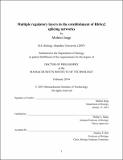| dc.contributor.advisor | Phillip A. Sharp. | en_US |
| dc.contributor.author | Jangi, Mohini (Mohini Rohit) | en_US |
| dc.contributor.other | Massachusetts Institute of Technology. Department of Biology. | en_US |
| dc.date.accessioned | 2014-05-23T19:33:44Z | |
| dc.date.available | 2014-05-23T19:33:44Z | |
| dc.date.copyright | 2014 | en_US |
| dc.date.issued | 2014 | en_US |
| dc.identifier.uri | http://hdl.handle.net/1721.1/87461 | |
| dc.description | Thesis: Ph. D., Massachusetts Institute of Technology, Department of Biology, 2014. | en_US |
| dc.description | Cataloged from PDF version of thesis. Vita. | en_US |
| dc.description | Includes bibliographical references. | en_US |
| dc.description.abstract | Regulated alternative splicing is mediated by RNA binding proteins (RBPs) recognizing short sequence motifs in nascent transcripts. The Rbfox RBPs are highly conserved splicing factors that regulate tissue-specific exon inclusion by binding the RNA motif UGCAUG. We sought to comprehensively define the Rbfox2 splicing regulatory network and discover determinants of Rbfox2 regulation in mouse embryonic stem cells. We uncovered fundamental principles in the mechanistic aspects of Rbfox-dependent splicing and in the systems-level regulation of interconnected splicing networks. Using high-resolution iCLIP and RNAseq, we identified many Rbfox2-mediated proteincoding splicing events and nearly 300 additional events, in particular those within RBPs, that are coupled to nonsense-mediated mRNA decay (NMD). Regulation of NMD-coupled splicing by Rbfox2 alters gene expression of autoregulated RBPs and hundreds of additional genes. These observations place Rbfox2 upstream of a large network of direct and indirect splicing changes and offer an explanation as to how autoregulated gene expression can be modulated. We describe a validation of RNA Bind-n-Seq, a novel in vitro technique for analyzing RNA-protein interactions. We found a secondary Rbfox2 motif, GCACG, to be functional in splicing regulation in addition to the consensus UGCAUG and observed a preference for Rbfox2 binding to unstructured sequences. These findings provide a foundation for establishing the critical determinants of functional cis elements in splicing regulation. We also investigated mechanisms of co-transcriptional splicing regulation by Rbfox2. Using chromatin immunoprecipitation, we found that Rbfox2 is recruited early in the transcription cycle to active promoters and transcriptional enhancers, likely via interaction and co-transcriptional tracking with RNA polymerase II. Modulation of chromatin structure alters Rbfox2-dependent splicing activity, supporting the emerging model that the chromatin environment influences exon choice. Our analyses of Rbfox2 activity in mouse embryonic stem cells reveal hundreds of previously unknown splicing targets involved in diverse biological functions. In particular, we introduce a novel concept in splicing regulation whereby changes in the expression of one splicing factor induce a cascade of secondary and perhaps tertiary splicing changes through cross-regulation of RBPs. This model positions RBPs at a critical node in the establishment, reinforcement, and alteration of tissue transcriptomes during mammalian development. | en_US |
| dc.description.statementofresponsibility | by Mohini Jangi. | en_US |
| dc.format.extent | 216 pages | en_US |
| dc.language.iso | eng | en_US |
| dc.publisher | Massachusetts Institute of Technology | en_US |
| dc.rights | M.I.T. theses are protected by copyright. They may be viewed from this source for any purpose, but reproduction or distribution in any format is prohibited without written permission. See provided URL for inquiries about permission. | en_US |
| dc.rights.uri | http://dspace.mit.edu/handle/1721.1/7582 | en_US |
| dc.subject | Biology. | en_US |
| dc.title | Multiple regulatory layers in the establishment of Rbfox2 splicing networks | en_US |
| dc.type | Thesis | en_US |
| dc.description.degree | Ph. D. | en_US |
| dc.contributor.department | Massachusetts Institute of Technology. Department of Biology | |
| dc.identifier.oclc | 879661805 | en_US |
